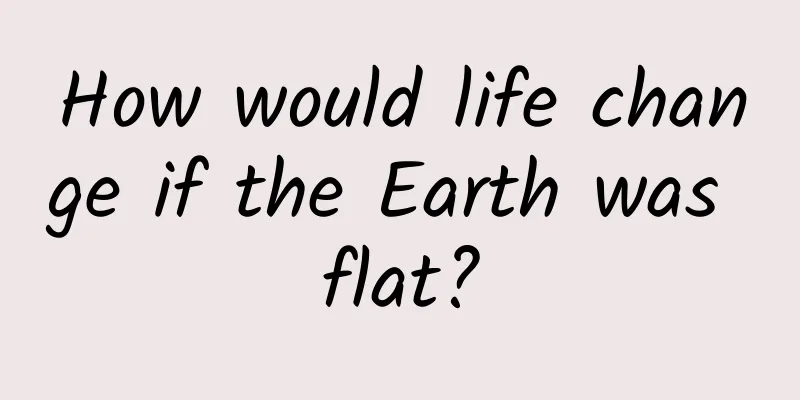How would life change if the Earth was flat?

|
A flat Earth would look very different from space. (Credit: Mark Garlick/Science Photo Library via Getty) Earth, a spherical blue marble, is our home. But what if the Earth is flat? After all, some people actually believe in this counterintuitive idea. Would daily life on a flat Earth work? If the Earth is flat, what a weird sphere, or "weird plane," would it be? Are there any benefits to living on a strange disk with the sun and moon spinning overhead like a cosmic merry-go-round? 1. Say goodbye to gravity Gravity guides plant roots to grow downward and stems to grow upward. If gravity were turned toward the North Pole, we could expect plant growth to be as strange as the trees shown here. (Image credit: Tim Graham via Getty) On a spherical Earth, gravity pulls on all objects equally, no matter where they are in the world. For the Earth to form a flat disk shape, it cannot be affected by gravity. Otherwise, gravity would quickly pull the Earth back into a sphere. A flat Earth might have no gravity at all, according to calculations by mathematician and physicist James Clerk Maxwell in the 1850s, because a solid, disk-shaped Earth couldn't exist under realistic gravity. Or perhaps on a flat Earth, gravity would pull everything toward the center of the disk, the North Pole. In that case, the farther you get from the North Pole, the more the gravitational pull on the disk's center point becomes horizontal, according to James Davis, a geophysicist at Columbia University's Lamont-Doherty Earth Observatory. That would wreak havoc around the world, but the world long jump record would be easily broken (as long as you orient yourself north before taking off). 2. The atmosphere will be purified Earth's atmosphere as seen from the International Space Station. (Image credit: ESA/NASA/Tim Peake) Without gravity, Earth would no longer be able to hold on to its atmosphere, a layer of gases that holds up the veil around the planet. Without this protective layer, Earth's skies would be dark, as light from the sun would no longer be scattered as it enters Earth's atmosphere. "The loss of atmospheric pressure would expose plants and animals to the vacuum of space, suffocating them in seconds," zoologist and educator Luis Villazon wrote in BBC Science Focus. 3. The weather will become cloudy and the rain may be biased to one side If the Earth was flat, gravity would pull water toward the North Pole, and the swollen oceans would pool at the center of the planet. (Credit: Joel Sharpe via Getty) If the pull of gravity was moving toward Earth's North Pole, precipitation would move toward it, too. That's because precipitation falls to Earth under the pull of gravity, and therefore would fall toward the point where gravity is strongest (the North Pole). Only at the center of the disk would rain fall in a straight line, as it does on Earth today. The farther out you go, the more horizontal the direction of precipitation becomes. Water from rivers and oceans would also flow toward the North Pole, meaning that huge oceans would pool at the center of the planet, and there would be little water at the edge of the planet, according to Columbia University's Lamont-Doherty Earth Observatory. 4. On a Flat Earth, We’d All Be Lost It's hard to imagine a world without GPS, we'd all be lost! (Image credit: Blend Images - Diego Cervo via Getty) If the Earth was flat, satellites would likely not exist, as they would have trouble operating on a flat surface. "Many of the satellites that society relies on wouldn't work, and I can't imagine how GPS would work on a flat Earth," James Davis, a geophysicist at Columbia University's Lamont-Doherty Earth Observatory, said in a statement. We rely on the Global Navigation Satellite System (GNSS) for everything from the GPS service on your phone to travel information and instant inventory management at supermarkets to ensure produce arrives as quickly as possible. What's more, satellite communications could save your life in an emergency using GPS to locate a caller's cell phone signal. On the bright side, at least on a flat Earth, humans would have horizontal rainfall to point us in the right direction (north). 5. Traveling on a flat Earth might take longer A flat Earth. (Image credit: Rebel Design Project / Alamy) On a flat Earth, travel times would be expected to be longer, not only because there would be no GPS navigation, but also because the distances we would need to travel would be longer. According to the "flat Earth" theory, the North Pole is located at the center of the Earth, and the South Pole forms a huge ice wall at its edge, which prevents people from falling off the surface of the Earth. However, if you can't fly around the Earth and are forced to fly across it, then travel times would increase significantly. For example, to fly from Australia (on one side of the Earth's flat surface) to McMurdo Station in Antarctica (on the other side of the Earth's flat surface), you would need to fly across the entire North Pole, North America, and South America. Traveling across Antarctica is also no longer possible (although it has been achieved many times on a spherical Earth) because the pesky ice wall would prevent such a trip. 6. Without the Aurora, we would all be fried? NASA astronaut Jack Fischer photographed the aurora borealis from the International Space Station. (Image credit: NASA) On a spherical Earth, the molten metal surrounding our core creates electric currents, which in turn create a magnetic field that protects us from one end of the planet to the other, according to NASA. But on a flat Earth, without a solid core to generate a magnetic field, the magnetosphere would cease to exist. The same is true for the auroras. When charged particles from the sun hit oxygen and nitrogen molecules in the magnetosphere, they release energy, creating incredible auroras. But even so, we don't need to worry about the absence of auroras because the Earth would no longer be protected from the solar wind. The Earth and everything on its surface would be subjected to harmful solar radiation, leaving a barren world similar to Mars, according to NASA. 7. We will have to share the same night sky On a flat Earth, we would all see the same night sky. (Image credit: Alan Dyer/VWPics/Universal Images Group via Getty Images) A flat Earth wouldn't be split into two hemispheres like ours is, so night and day wouldn't change depending on whether you're in the Northern or Southern Hemisphere. The night sky would be the same no matter where you stand on Earth. It would certainly make stargazing easier, since you wouldn't have to travel to the other hemisphere to fulfill all the goals on your astronomy bucket list. Isn't that part of the fun? If we all only saw one part of the night sky, we'd miss out on a lot of sights, since we need to see 360 degrees of the observable universe from Earth, and can only rely entirely on space telescopes to expand our view of the cosmos. 8. Hurricanes will become a thing of the past Hurricane Florence as seen from the International Space Station. (Image credit: NASA) Every year, hurricanes (also known as typhoons and cyclones, depending on where they form) wreak havoc. In 2017, Hurricane Harvey alone cost the US $125 billion (£90 billion), according to NOAA. The destructive spinning nature of these tropical storms stems from Earth's Coriolis effect, which causes storms in the Northern Hemisphere to spin counter-clockwise, while those in the Southern Hemisphere spin clockwise. However, on a stationary, flat Earth, the Coriolis effect doesn't occur. This means there are no hurricanes, typhoons or cyclones. It's also why we don't see these types of storms between 5 degrees north and 5 degrees south of the equator. At the equator, the Coriolis effect is zero, according to NASA. BY: Daisy Dobrijevic FY: Xu Zhanbo If there is any infringement of related content, please contact the author to delete it after the work is published. Please obtain authorization for reprinting, and pay attention to maintaining integrity and indicating the source |
<<: Why does the spring breeze not reach Yumen Pass? Look at the map and you will see the answer.
>>: After revenge, I was "revengeful", the unbearable "weight of eating raw seafood"
Recommend
Increase followers, promotion, IP building, and Weibo operation skills!
Weibo is a social networking platform with great ...
Haidilao's ads will become invisible丨6 ways to make ads invisible
I have previously written an article about how “ ...
After he sold the company, he paid his employees 150 months’ salary!
This is an article that reflects the boss's c...
How does a novice choose a web server for rental?
How does a novice choose a website server for ren...
Mercedes-Benz S-Class new cars recalled due to internal tie rod risk, official apology rare
Last year alone, Mercedes-Benz was called the &qu...
Are you in the right shape for hula hooping? Mathematicians prove it →
Compiled by: Gong Zixin Mechanical systems with m...
Audi dealers should stop fighting: they are pushing consumers out the door
On November 11, Audi and SAIC signed a framework ...
Monkey stories: The ons and offs of black and white leaf monkeys
Primates are close relatives of humans. The most ...
How good is the product manager in a programmer’s dream?
The conflicts between programmers and product man...
BYD released the Honor Edition Han Tang, and taught Xiaomi how to build cars. The industry officially entered the knockout round
Just after the Spring Festival, BYD dropped a bom...
How to modify SEO when a new website is launched? How to perform SEO optimization?
Due to inadequate early planning of location cons...
World Book Day丨You look so beautiful when you read!
Reading enriches our souls. Let us have more cour...
How did the ancients prevent fire during the Qin and Han dynasties?
The Qin and Han dynasties are collectively known ...
For the first time, humans have predicted in advance that a probe is about to pass through the comet's tail. Let's take a look at what this comet looks like!
ESA's Solar Orbiter will pass through the tai...
This anniversary is celebrated twice a year!
Most anniversaries are celebrated only once a yea...









